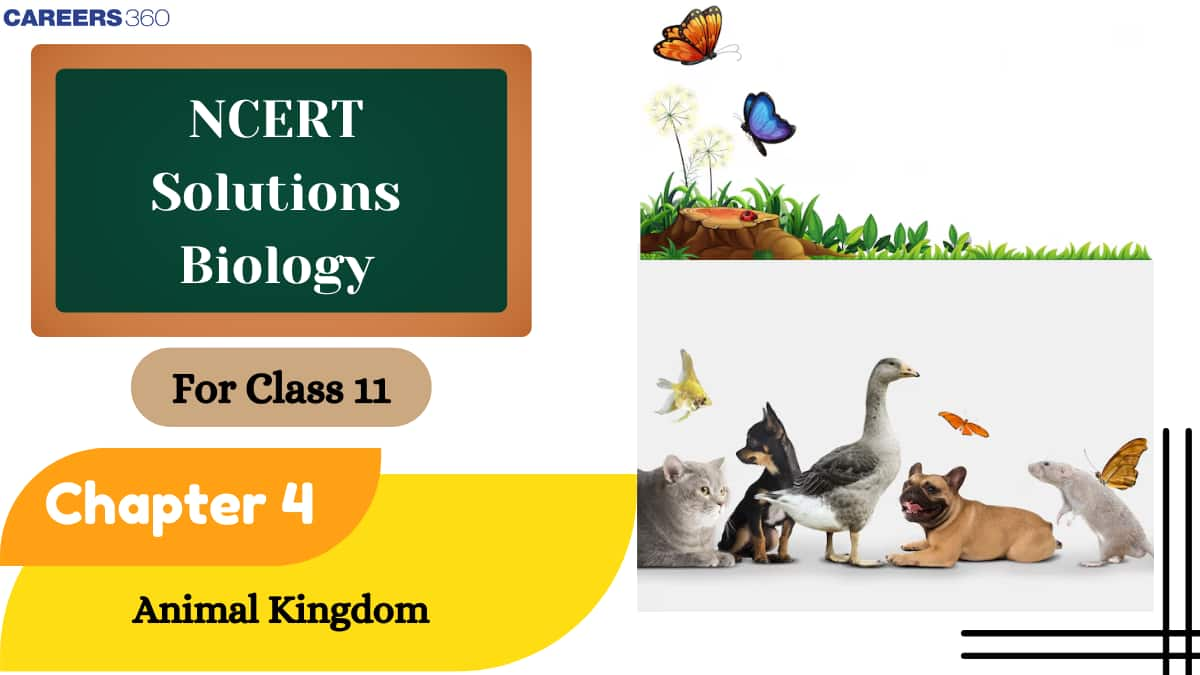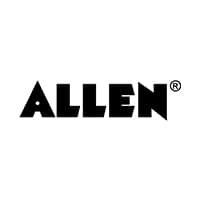ALLEN Coaching
ApplyRegister for ALLEN Scholarship Test & get up to 90% Scholarship
NCERT Solutions for Class 11 Biology Chapter 4 help students in understanding the diversity of animals. They describe how the animals are classified based on features such as body structure, cell organisation, symmetry, and body cavity presence. NCERT Solutions for Class 11 offer clear explanations to simplify learning about animal classification.
New: Get up to 90% Scholarship on NEET/JEE Coaching from top Coaching Institutes
NEET Scholarship Test Kit (Class 11): Narayana | Physics Wallah | Aakash | ALLEN
Browse: NEET papers with solutions | Most scoring concepts for NEET

The NCERT Solutions give clear, step-by-step answers to all questions of the chapter according to the latest CBSE syllabus. They include important points such as classification, animal phyla, and characteristic features like segmentation and notochord. Complex terms are explained in simple words so that students can learn easily. The solutions are easy to download and assist students in preparing well for the board and competitive exams.
Given below is the PDF of the detailed question and answer of this chapter:
Also Read,
Given below are the exercise questions with detailed explanations for better understanding.
Answer: Basic characteristics help in grouping animals while indicating their differences. All animals do not have cell walls and are dependent on other organisms for nutrition, but mammals have special characteristics such as mammary glands.
Without these basic characteristics, it would be hard to classify because:
In brief, basic characteristics are responsible for classifying animals and telling us about their evolution.
Q2. If you are given a specimen, what are the steps that you would follow to classify it?
Answer: To identify an unknown specimen, look at these most important features:
Level of Organisation: Cells, tissues, or organs.
Body Symmetry: Radial or bilateral.
Germ Layers: Two (diploblastic) or three (triploblastic).
Body Cavity: Present or absent.
Coelom: True (coelomate), false (pseudocoelomate), or none (acoelomate).
Answer: The coelom and body cavities are important in the classification of animals. A coelom is a body cavity filled with fluid, lined by embryonic tissue.
Dividing animals into categories according to their coelom helps us to understand their development and evolutionary history.
Q4. Distinguish between intracellular and extracellular digestion.
Answer: The differences between intracellular and extracellular digestion are as follows
Characteristics | Intracellular Digestion | Extracellular Digestion |
Where Digestion Occurs | Inside cells | Outside cells, in the alimentary canal |
Number of Enzymes | Few enzymes | Many enzymes |
How Nutrients are Absorbed | Diffused into the cytoplasm | Absorbed across the intestinal wall into the body |
Common in | Unicellular animals | Multicellular animals |
Q5. What is the difference between direct and indirect development?
Answer: The differences between direct and indirect development are as follows
Direct Development | Indirect Development |
No larval stages | Includes larval stages |
Resemble adults | Don't resemble adults |
Fishes, reptiles, birds, and mammals | Invertebrates, amphibians |
Q6. What are the peculiar features that you find in parasitic Platyhelminthes?
Answer:– Platyhelminthes have several unique characteristics:
They have a thick tegument that shields them from the digestive enzymes of their hosts.
Their bodies are dorsoventrally flattened, i.e., flat from top to bottom.
They have suckers and hooks that help them in sticking to their hosts and obtaining nutrition.
They do not possess organs for movement, so they use other means to move.
Their reproductive system is well developed, and they are mostly hermaphroditic, having both male and female reproductive organs.
Answer: The reasons for arthropods being the largest group of animals are as follows:
They have a thick cuticle that helps them to thrive in many types of environments, particularly on land.
They have striated muscles that help in rapid and effective movement.
They have a tracheal system of respiration that brings oxygen directly to their cells, which is extremely effective.
They possess joint appendages that are capable of performing numerous different functions, so they are very adaptable.
They have a highly developed nervous system and sense organs that help them effectively sense and react to their surroundings.
They communicate using pheromones, which help in social behaviour and reproduction.
Q8. The water vascular system is characteristic of which group of the following:
(a) Porifera
(b) Ctenophora
(c) Echinodermata
(d) Chordata
Answer: The correct option is (c) Echinodermata
The water vascular system is a characteristic feature of echinoderms which helps in locomotion, respiration and capturing of food.
Q9. "All vertebrates are chordates but all chordates are not vertebrates." Justify the statement.
Answer: Phylum Chordata contains animals that have a notochord, i.e., an elastic rod-shaped structure. Phylum Chordata is still divided into three sub-phyla: Urochordata, Cephalochordata, and Vertebrata. During vertebrates, the notochord is superseded by a vertebral column, but within urochordates and cephalochordates, there is no vertebral column present. Therefore, all vertebrates are chordates, but they are not necessarily vertebrates, as they can also be urochordates or cephalochordates.
Q10. How important is the presence of an air bladder in Pisces?
Answer: Osteichthyes (bony fishes, such as salmon) have an air bladder, which keeps them buoyant and prevents them from sinking in water. It makes them remain at a specific depth without swimming continuously. Chondrichthyes (cartilaginous fishes, such as sharks) do not have an air bladder. They need to swim continuously, employing their fins and body to remain afloat to avoid sinking.
The air bladder functions as a buoyancy support, whereas sharks survive using motion.
Q11. What are the modifications that are observed in birds that help them fly?
Answer: Birds have some adaptations that help them to fly:
Q12. Could the number of eggs or young ones produced by an oviparous and viviparous mother be equal? Why?
Answer: Oviparous creatures lay eggs outside the body and generally give birth to a greater number of offspring, as they are given little parental care and exposed to severe environmental conditions. Viviparous creatures, on the other hand, give birth to live offspring and offer care both pre- and post-birth. This greater parental care leads to greater survival rates, reducing the necessity for a high number of offspring. Thus, the number of eggs or young ones given birth to by oviparous and viviparous mothers is not the same.
Q13. Segmentation in the body is first observed in which of the following:
(a) Platyhelminthes
(b) Aschelminthes
(c) Annelida
(d) Arthropoda
Answer: The correct option is (c) Annelida
Q14. Match the following:
(a) Operculum (i) Ctenophora
(b) Parapodia (ii) Mollusca
(c) Scales (iii) Porifera
(d) Comb plates (iv) Reptilia
(e) Radula (v) Annelida
(f ) Hairs (vi) Cyclostomata and Chondrichthyes
(g) Choanocytes (vii) Mammalia
(h) Gill slits (viii) Osteichthyes
Answer: (a)-(viii), (b)-(v), (c)-(iv), (d)-(i), (e)-(ii), (f)- (vii), (g)- (iii), (h)- (vi)
| Operculum | (viii) Osteichthyes |
| Parapodia | (v) Annelida |
| Scales | (iv) Reptilia |
| Comb plates | (i) Ctenophora |
| Radula | (ii) Mollusca |
| Hairs | (vii) Mammalia |
| Choanocytes | (iii) Porifera |
| Gill slits | (vi) Cyclostomata and Chondrichthyes |
Q15. Prepare a list of some animals that are found parasitic on human beings.
Answer: Taenia ( Tapeworm)
Ascaris (roundworm)
Ancylostoma (hookworm)
Enterobius (pinworm)
Wuchereria (filarial worm)
NCERT Solutions for Class 11: Subject-wise
This chapter is very vast and interesting, focusing on key questions can help you understand its complexity and classification."
Question 1: The following are the statements about non-chordates:
A. gill slits perforate pharynx.
B. Notochord is absent.
C. The central nervous system is dorsal.
D. Heart is dorsal if present.
E. Post-anal tail is absent.
Choose the most appropriate answer from the options given below:
1. A & C only
2. A, B & D only
3. B, D & E only
4. B, C & D only
Answer:
In invertebrates, the notochord, a defining feature of chordates, is absent, and their body structure is often supported by other means, like exoskeletons or hydrostatic skeletons. If a heart is present, it is typically located dorsally, unlike the ventral heart found in chordates. In addition, they lack a post-anal tail, which is a characteristic feature of chordates and plays a role in locomotion or balance in those organisms.
Hence, the correct answer is option 3, B, D & E only
Also, check the NCERT Books and the NCERT Syllabus here:
The approach to solving questions of this chapter involves a clear understanding of the animal kingdom. Students can follow the steps given below:
To do well in NEET, students should study extra topics and practice more beyond the NCERT, as shown in the table below.
Below are the chapter-wise solutions:
These are the differences between intracellular and extracellular digestion:
| Intracellular digestion | Extracellular digestion |
| The process of digestion of food takes place inside the cells | The process of digestion of food takes place outside the cells in the alimentary canal. |
| Only a few enzymes are involved in the process of digestion | A number of enzymes are involved in extracellular digestion |
| The products of digestion are diffused into the cytoplasm | The products of digestion across the intestinal wall into the body parts |
NCERT Solutions for Class 11 Biology Chapter 4 Animal Kingdom make it easy for students to learn about animal classification. They give precise and correct answers to textbook questions as per the current CBSE syllabus. They explain complicated topics in an easier way, simplifying learning. They also give important diagrams and key points that help in exams. Students can quickly revise, improve their knowledge, and achieve better marks in exams using NCERT Solutions.
The important topics of animal kingdom class 11 NCERT are:
In the board exam, questions from Chapter 4 Animal Kingdom on classification, features, and examples of various animal groups can be expected. Some main questions are:
These questions can be short answer, long answer, or diagram-based, therefore it is important to understand the key concepts to score well.
The following list of animals found to be human parasites is taken from Chapter 4 of the NCERT Solutions for Class 11 Biology:
Animals are multicellular, heterotrophic, and have well-developed sense organs. Most can move and respond to stimuli. They are classified based on features like symmetry and body structure.
Classification is based on features like body symmetry, presence of a coelom, and notochord. Animals are grouped into phyla such as Porifera, Arthropoda, and Chordata.
The differences between chordates and non-chordates in Class 11 NCERT solutions are given in the table below:
Feature | Chordates | Non-Chordates |
Notochord | Present at some stage | Absent |
Dorsal Hollow Nerve Cord | Present | Absent |
Pharyngeal Slits | Present at some stage | Absent |
Animals are classified as asymmetrical, radially symmetrical, or bilaterally symmetrical based on their body structure.
Major phyla include Porifera, Coelenterata, Platyhelminthes, Annelida, Arthropoda, Mollusca, Echinodermata, Hemichordata, and Chordata.
Sponges are considered primitive due to their simple cellular-level organization and lack of tissues or organs.
Animals are classified based on features such as body organization, symmetry, coelom, level of organization, segmentation, and patterns of organ systems.

Register for ALLEN Scholarship Test & get up to 90% Scholarship

Get up to 90% Scholarship on Offline NEET/JEE coaching from top Institutes

This ebook serves as a valuable study guide for NEET 2025 exam.

This e-book offers NEET PYQ and serves as an indispensable NEET study material.

As per latest 2024 syllabus. Physics formulas, equations, & laws of class 11 & 12th chapters
As per latest 2024 syllabus. Chemistry formulas, equations, & laws of class 11 & 12th chapters